Glaxosmith Plc: India Market Entry Strategy and Analysis Report
VerifiedAdded on 2021/02/20
|13
|3925
|31
Report
AI Summary
This report provides a comprehensive analysis of Glaxosmith Plc's potential market entry into India, focusing on the introduction of new pharmaceutical equipment like BP check machines. The report begins with an introduction outlining the objectives, which include recommending the best location for market entry and analyzing the target market for new product launches. The main analysis section delves into the scenario, introducing the product and the Indian market context. It then applies the PESTLE analysis to assess the political, economic, social, technological, environmental, and legal factors influencing the market. The report further explores market entry options, including franchising, joint ventures, and strategic alliances, recommending franchising as the most suitable approach. Market segmentation and Porter's generic strategies are also examined to provide a strategic marketing plan. The conclusion summarizes the findings, and recommendations are provided to guide Glaxosmith Plc's expansion into the Indian market, with a focus on understanding market dynamics, adapting to social trends, and navigating legal and regulatory frameworks.
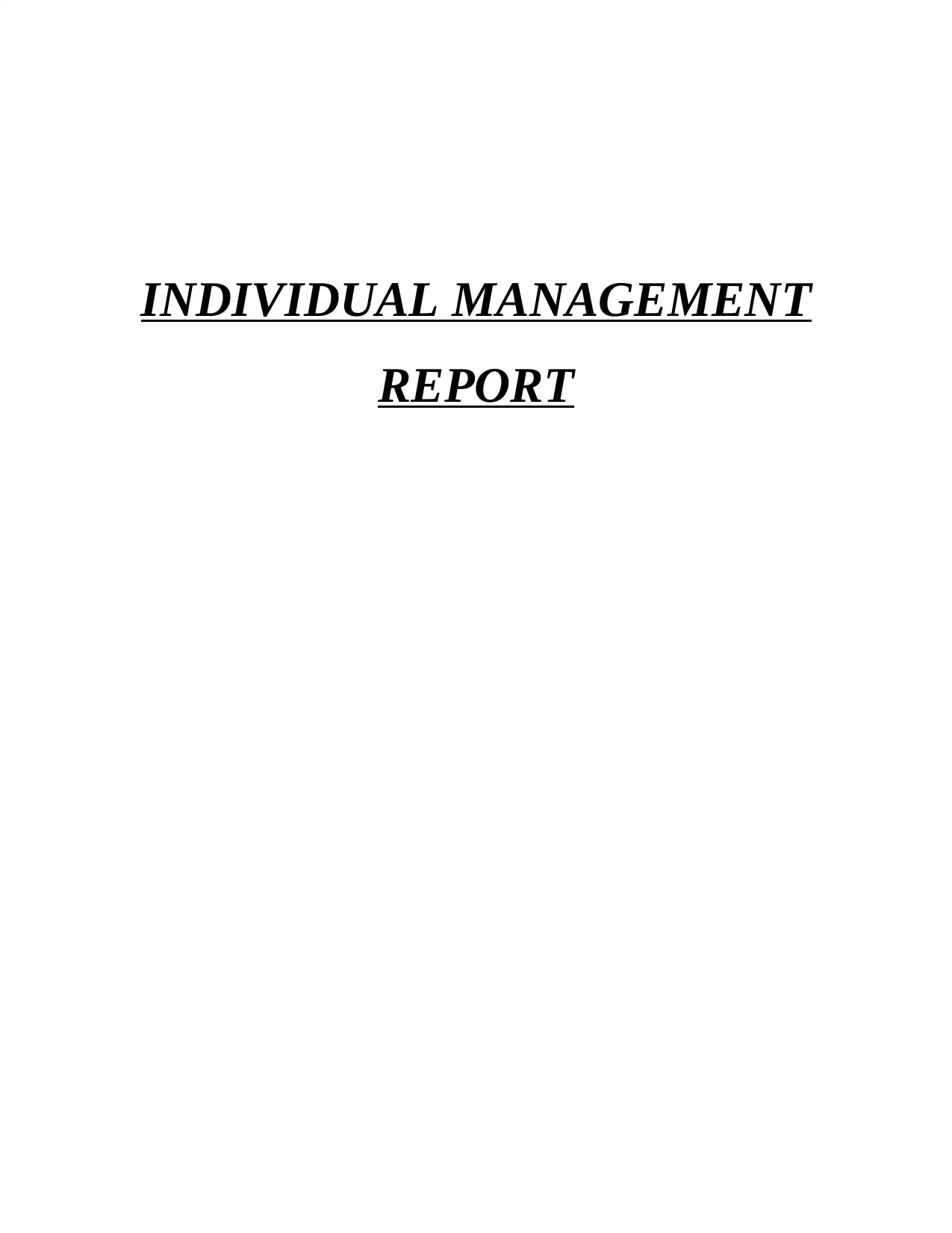
INDIVIDUAL MANAGEMENT
REPORT
REPORT
Paraphrase This Document
Need a fresh take? Get an instant paraphrase of this document with our AI Paraphraser
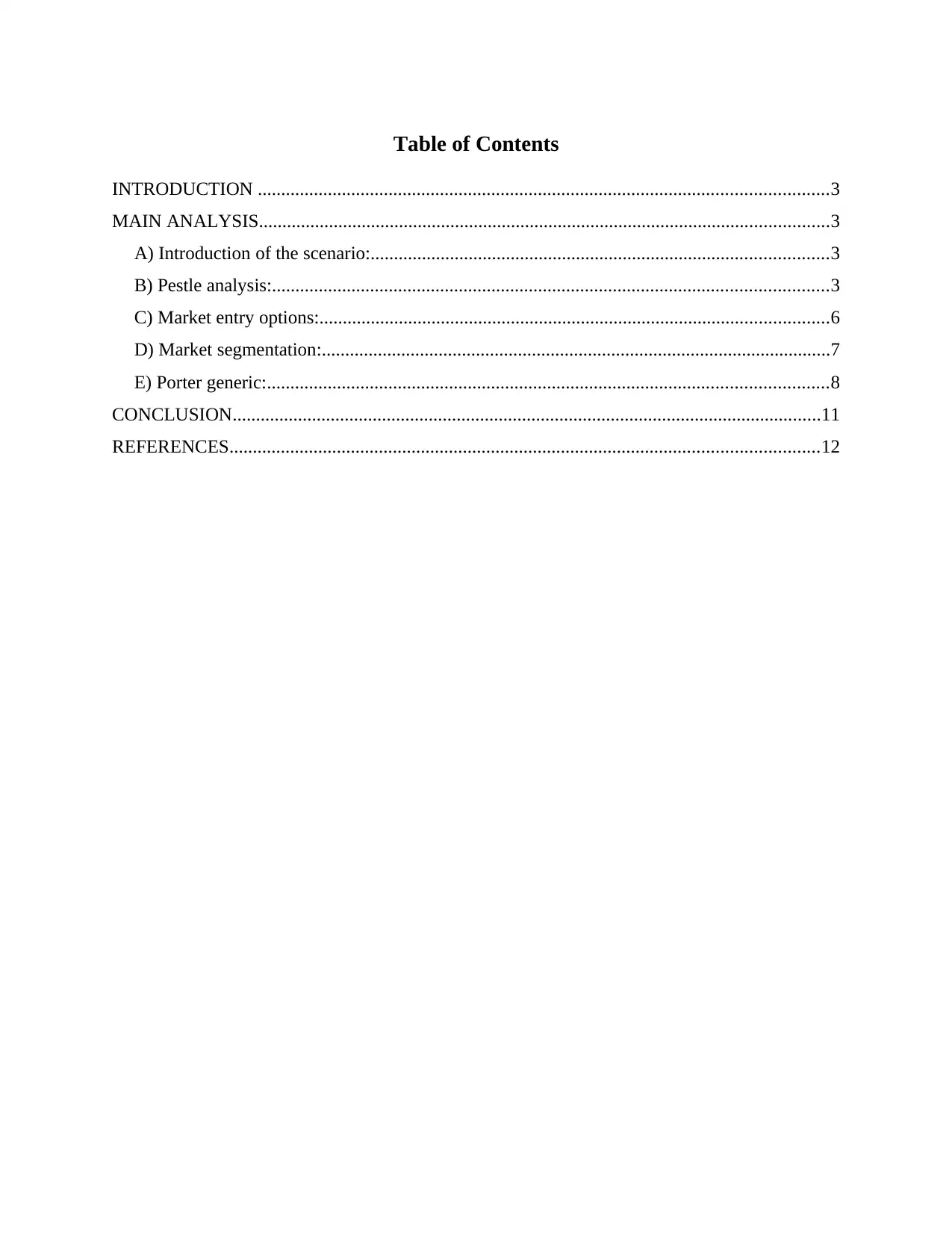
Table of Contents
INTRODUCTION ..........................................................................................................................3
MAIN ANALYSIS..........................................................................................................................3
A) Introduction of the scenario:..................................................................................................3
B) Pestle analysis:.......................................................................................................................3
C) Market entry options:.............................................................................................................6
D) Market segmentation:.............................................................................................................7
E) Porter generic:........................................................................................................................8
CONCLUSION..............................................................................................................................11
REFERENCES..............................................................................................................................12
INTRODUCTION ..........................................................................................................................3
MAIN ANALYSIS..........................................................................................................................3
A) Introduction of the scenario:..................................................................................................3
B) Pestle analysis:.......................................................................................................................3
C) Market entry options:.............................................................................................................6
D) Market segmentation:.............................................................................................................7
E) Porter generic:........................................................................................................................8
CONCLUSION..............................................................................................................................11
REFERENCES..............................................................................................................................12
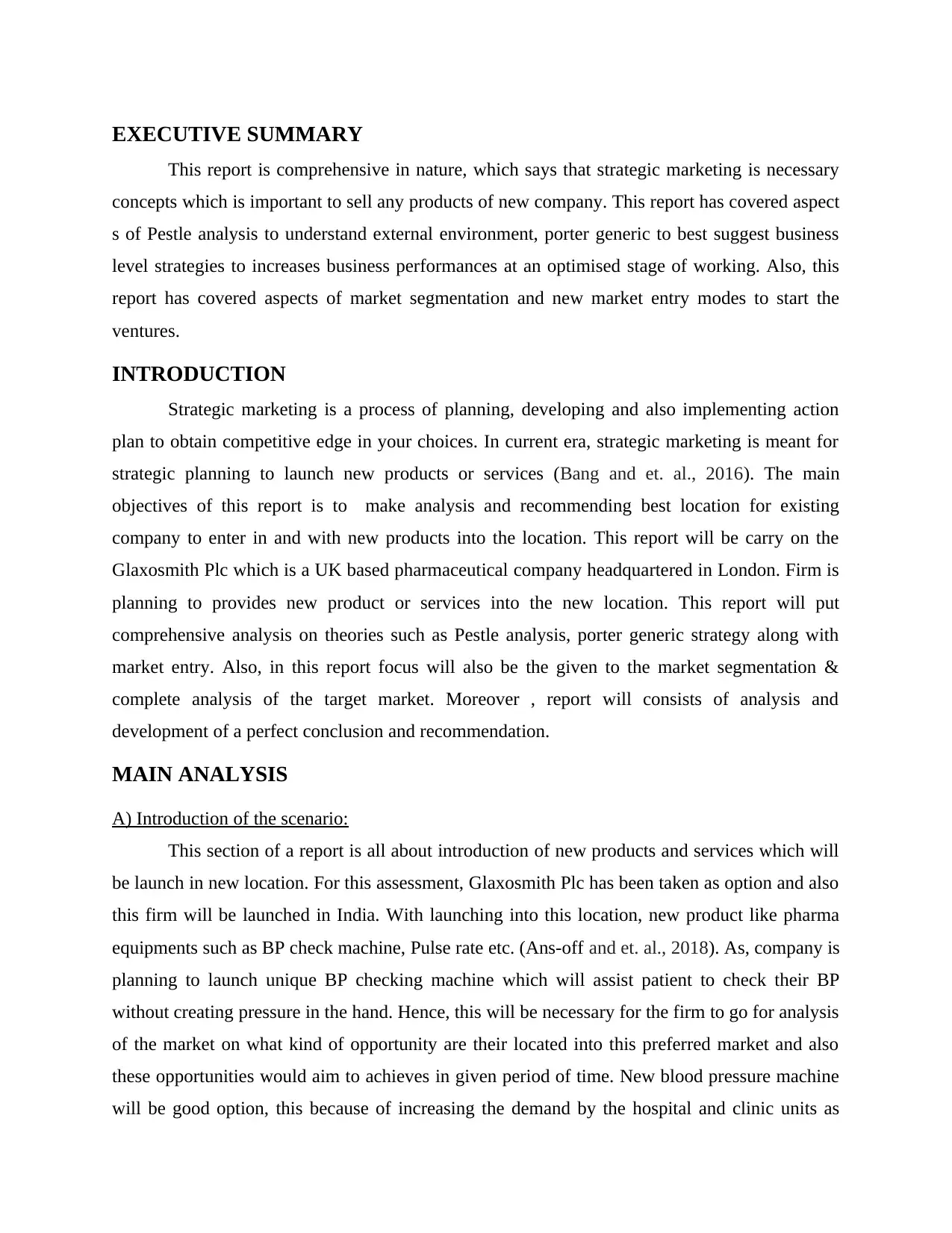
EXECUTIVE SUMMARY
This report is comprehensive in nature, which says that strategic marketing is necessary
concepts which is important to sell any products of new company. This report has covered aspect
s of Pestle analysis to understand external environment, porter generic to best suggest business
level strategies to increases business performances at an optimised stage of working. Also, this
report has covered aspects of market segmentation and new market entry modes to start the
ventures.
INTRODUCTION
Strategic marketing is a process of planning, developing and also implementing action
plan to obtain competitive edge in your choices. In current era, strategic marketing is meant for
strategic planning to launch new products or services (Bang and et. al., 2016). The main
objectives of this report is to make analysis and recommending best location for existing
company to enter in and with new products into the location. This report will be carry on the
Glaxosmith Plc which is a UK based pharmaceutical company headquartered in London. Firm is
planning to provides new product or services into the new location. This report will put
comprehensive analysis on theories such as Pestle analysis, porter generic strategy along with
market entry. Also, in this report focus will also be the given to the market segmentation &
complete analysis of the target market. Moreover , report will consists of analysis and
development of a perfect conclusion and recommendation.
MAIN ANALYSIS
A) Introduction of the scenario:
This section of a report is all about introduction of new products and services which will
be launch in new location. For this assessment, Glaxosmith Plc has been taken as option and also
this firm will be launched in India. With launching into this location, new product like pharma
equipments such as BP check machine, Pulse rate etc. (Ans-off and et. al., 2018). As, company is
planning to launch unique BP checking machine which will assist patient to check their BP
without creating pressure in the hand. Hence, this will be necessary for the firm to go for analysis
of the market on what kind of opportunity are their located into this preferred market and also
these opportunities would aim to achieves in given period of time. New blood pressure machine
will be good option, this because of increasing the demand by the hospital and clinic units as
This report is comprehensive in nature, which says that strategic marketing is necessary
concepts which is important to sell any products of new company. This report has covered aspect
s of Pestle analysis to understand external environment, porter generic to best suggest business
level strategies to increases business performances at an optimised stage of working. Also, this
report has covered aspects of market segmentation and new market entry modes to start the
ventures.
INTRODUCTION
Strategic marketing is a process of planning, developing and also implementing action
plan to obtain competitive edge in your choices. In current era, strategic marketing is meant for
strategic planning to launch new products or services (Bang and et. al., 2016). The main
objectives of this report is to make analysis and recommending best location for existing
company to enter in and with new products into the location. This report will be carry on the
Glaxosmith Plc which is a UK based pharmaceutical company headquartered in London. Firm is
planning to provides new product or services into the new location. This report will put
comprehensive analysis on theories such as Pestle analysis, porter generic strategy along with
market entry. Also, in this report focus will also be the given to the market segmentation &
complete analysis of the target market. Moreover , report will consists of analysis and
development of a perfect conclusion and recommendation.
MAIN ANALYSIS
A) Introduction of the scenario:
This section of a report is all about introduction of new products and services which will
be launch in new location. For this assessment, Glaxosmith Plc has been taken as option and also
this firm will be launched in India. With launching into this location, new product like pharma
equipments such as BP check machine, Pulse rate etc. (Ans-off and et. al., 2018). As, company is
planning to launch unique BP checking machine which will assist patient to check their BP
without creating pressure in the hand. Hence, this will be necessary for the firm to go for analysis
of the market on what kind of opportunity are their located into this preferred market and also
these opportunities would aim to achieves in given period of time. New blood pressure machine
will be good option, this because of increasing the demand by the hospital and clinic units as
⊘ This is a preview!⊘
Do you want full access?
Subscribe today to unlock all pages.

Trusted by 1+ million students worldwide
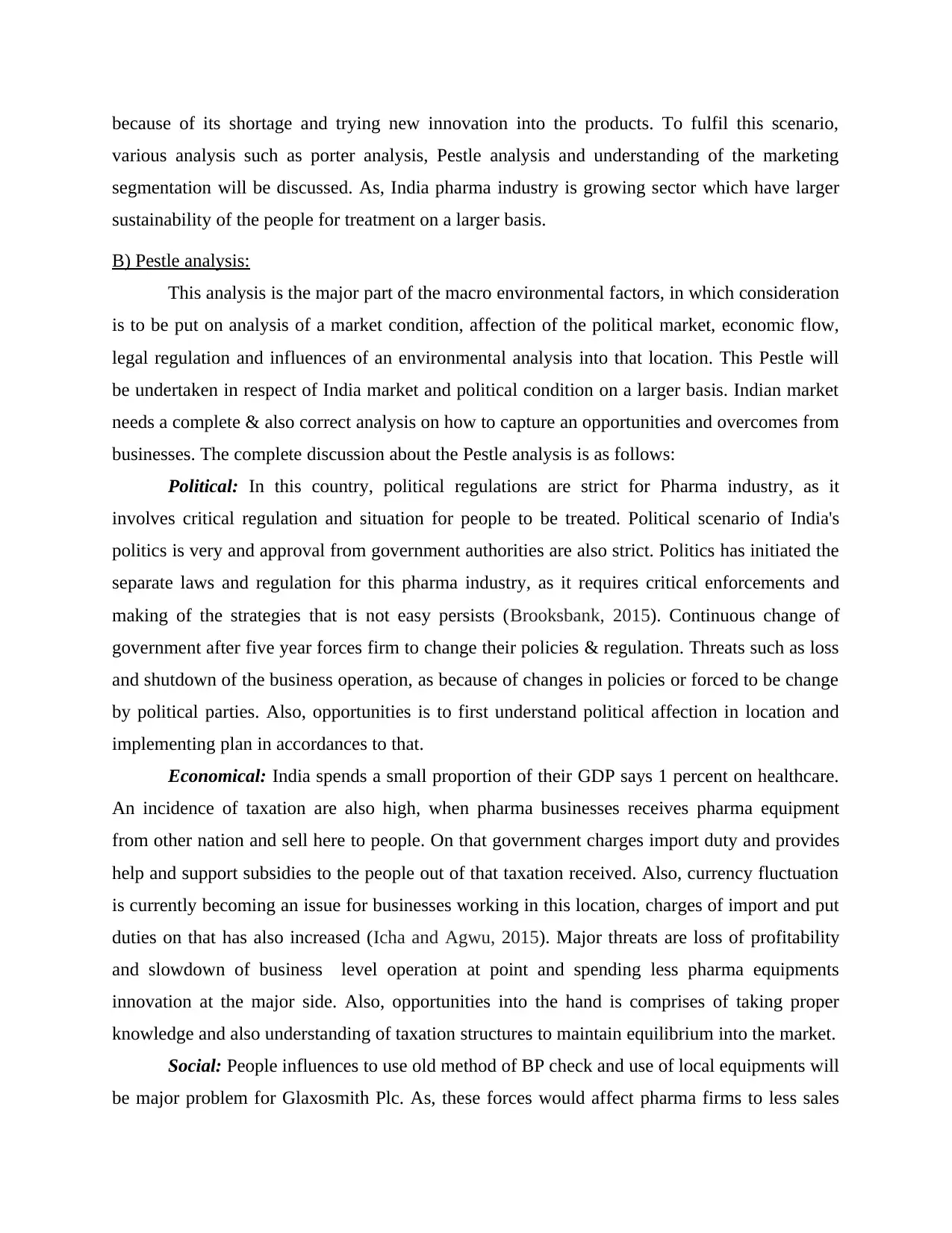
because of its shortage and trying new innovation into the products. To fulfil this scenario,
various analysis such as porter analysis, Pestle analysis and understanding of the marketing
segmentation will be discussed. As, India pharma industry is growing sector which have larger
sustainability of the people for treatment on a larger basis.
B) Pestle analysis:
This analysis is the major part of the macro environmental factors, in which consideration
is to be put on analysis of a market condition, affection of the political market, economic flow,
legal regulation and influences of an environmental analysis into that location. This Pestle will
be undertaken in respect of India market and political condition on a larger basis. Indian market
needs a complete & also correct analysis on how to capture an opportunities and overcomes from
businesses. The complete discussion about the Pestle analysis is as follows:
Political: In this country, political regulations are strict for Pharma industry, as it
involves critical regulation and situation for people to be treated. Political scenario of India's
politics is very and approval from government authorities are also strict. Politics has initiated the
separate laws and regulation for this pharma industry, as it requires critical enforcements and
making of the strategies that is not easy persists (Brooksbank, 2015). Continuous change of
government after five year forces firm to change their policies & regulation. Threats such as loss
and shutdown of the business operation, as because of changes in policies or forced to be change
by political parties. Also, opportunities is to first understand political affection in location and
implementing plan in accordances to that.
Economical: India spends a small proportion of their GDP says 1 percent on healthcare.
An incidence of taxation are also high, when pharma businesses receives pharma equipment
from other nation and sell here to people. On that government charges import duty and provides
help and support subsidies to the people out of that taxation received. Also, currency fluctuation
is currently becoming an issue for businesses working in this location, charges of import and put
duties on that has also increased (Icha and Agwu, 2015). Major threats are loss of profitability
and slowdown of business level operation at point and spending less pharma equipments
innovation at the major side. Also, opportunities into the hand is comprises of taking proper
knowledge and also understanding of taxation structures to maintain equilibrium into the market.
Social: People influences to use old method of BP check and use of local equipments will
be major problem for Glaxosmith Plc. As, these forces would affect pharma firms to less sales
various analysis such as porter analysis, Pestle analysis and understanding of the marketing
segmentation will be discussed. As, India pharma industry is growing sector which have larger
sustainability of the people for treatment on a larger basis.
B) Pestle analysis:
This analysis is the major part of the macro environmental factors, in which consideration
is to be put on analysis of a market condition, affection of the political market, economic flow,
legal regulation and influences of an environmental analysis into that location. This Pestle will
be undertaken in respect of India market and political condition on a larger basis. Indian market
needs a complete & also correct analysis on how to capture an opportunities and overcomes from
businesses. The complete discussion about the Pestle analysis is as follows:
Political: In this country, political regulations are strict for Pharma industry, as it
involves critical regulation and situation for people to be treated. Political scenario of India's
politics is very and approval from government authorities are also strict. Politics has initiated the
separate laws and regulation for this pharma industry, as it requires critical enforcements and
making of the strategies that is not easy persists (Brooksbank, 2015). Continuous change of
government after five year forces firm to change their policies & regulation. Threats such as loss
and shutdown of the business operation, as because of changes in policies or forced to be change
by political parties. Also, opportunities is to first understand political affection in location and
implementing plan in accordances to that.
Economical: India spends a small proportion of their GDP says 1 percent on healthcare.
An incidence of taxation are also high, when pharma businesses receives pharma equipment
from other nation and sell here to people. On that government charges import duty and provides
help and support subsidies to the people out of that taxation received. Also, currency fluctuation
is currently becoming an issue for businesses working in this location, charges of import and put
duties on that has also increased (Icha and Agwu, 2015). Major threats are loss of profitability
and slowdown of business level operation at point and spending less pharma equipments
innovation at the major side. Also, opportunities into the hand is comprises of taking proper
knowledge and also understanding of taxation structures to maintain equilibrium into the market.
Social: People influences to use old method of BP check and use of local equipments will
be major problem for Glaxosmith Plc. As, these forces would affect pharma firms to less sales
Paraphrase This Document
Need a fresh take? Get an instant paraphrase of this document with our AI Paraphraser
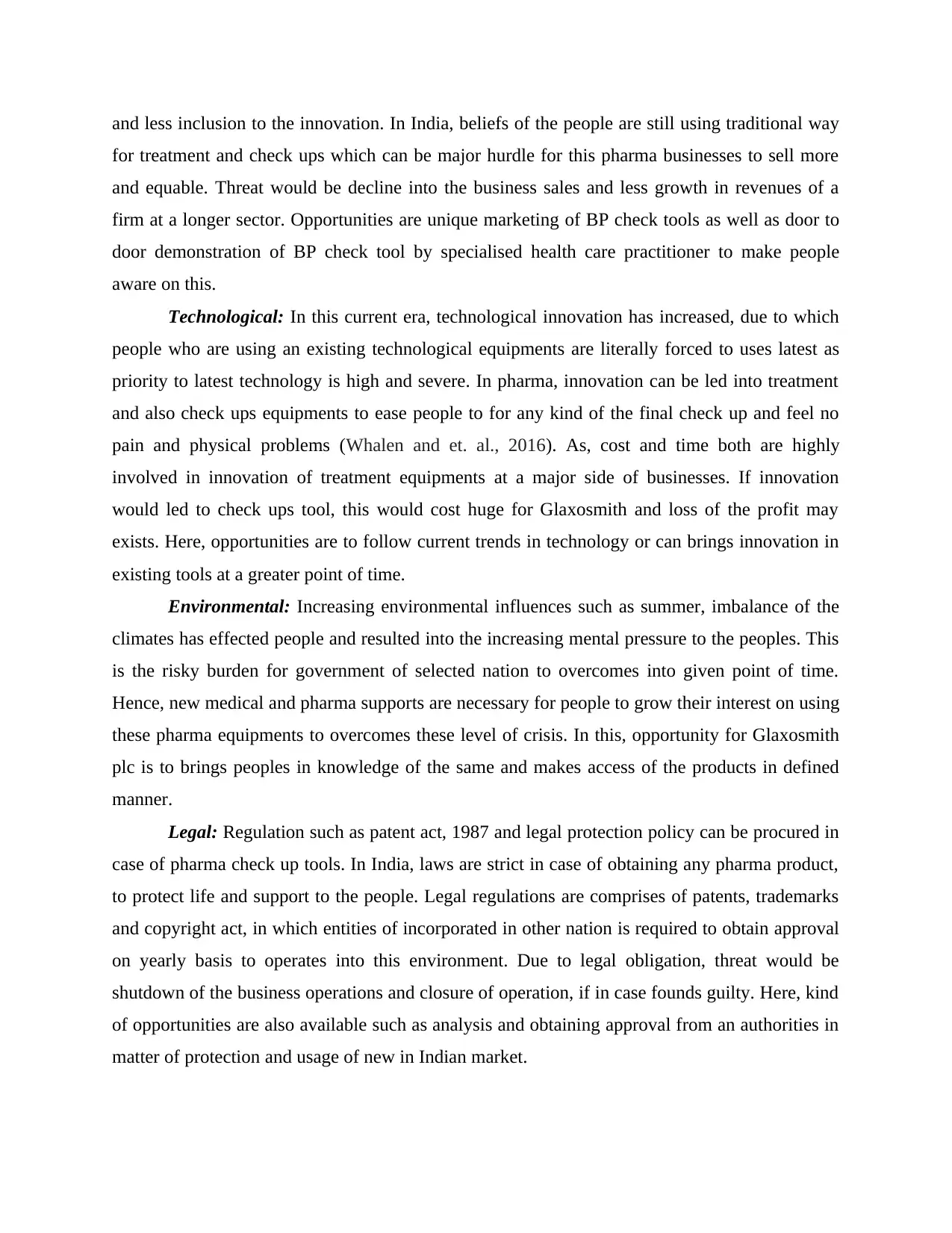
and less inclusion to the innovation. In India, beliefs of the people are still using traditional way
for treatment and check ups which can be major hurdle for this pharma businesses to sell more
and equable. Threat would be decline into the business sales and less growth in revenues of a
firm at a longer sector. Opportunities are unique marketing of BP check tools as well as door to
door demonstration of BP check tool by specialised health care practitioner to make people
aware on this.
Technological: In this current era, technological innovation has increased, due to which
people who are using an existing technological equipments are literally forced to uses latest as
priority to latest technology is high and severe. In pharma, innovation can be led into treatment
and also check ups equipments to ease people to for any kind of the final check up and feel no
pain and physical problems (Whalen and et. al., 2016). As, cost and time both are highly
involved in innovation of treatment equipments at a major side of businesses. If innovation
would led to check ups tool, this would cost huge for Glaxosmith and loss of the profit may
exists. Here, opportunities are to follow current trends in technology or can brings innovation in
existing tools at a greater point of time.
Environmental: Increasing environmental influences such as summer, imbalance of the
climates has effected people and resulted into the increasing mental pressure to the peoples. This
is the risky burden for government of selected nation to overcomes into given point of time.
Hence, new medical and pharma supports are necessary for people to grow their interest on using
these pharma equipments to overcomes these level of crisis. In this, opportunity for Glaxosmith
plc is to brings peoples in knowledge of the same and makes access of the products in defined
manner.
Legal: Regulation such as patent act, 1987 and legal protection policy can be procured in
case of pharma check up tools. In India, laws are strict in case of obtaining any pharma product,
to protect life and support to the people. Legal regulations are comprises of patents, trademarks
and copyright act, in which entities of incorporated in other nation is required to obtain approval
on yearly basis to operates into this environment. Due to legal obligation, threat would be
shutdown of the business operations and closure of operation, if in case founds guilty. Here, kind
of opportunities are also available such as analysis and obtaining approval from an authorities in
matter of protection and usage of new in Indian market.
for treatment and check ups which can be major hurdle for this pharma businesses to sell more
and equable. Threat would be decline into the business sales and less growth in revenues of a
firm at a longer sector. Opportunities are unique marketing of BP check tools as well as door to
door demonstration of BP check tool by specialised health care practitioner to make people
aware on this.
Technological: In this current era, technological innovation has increased, due to which
people who are using an existing technological equipments are literally forced to uses latest as
priority to latest technology is high and severe. In pharma, innovation can be led into treatment
and also check ups equipments to ease people to for any kind of the final check up and feel no
pain and physical problems (Whalen and et. al., 2016). As, cost and time both are highly
involved in innovation of treatment equipments at a major side of businesses. If innovation
would led to check ups tool, this would cost huge for Glaxosmith and loss of the profit may
exists. Here, opportunities are to follow current trends in technology or can brings innovation in
existing tools at a greater point of time.
Environmental: Increasing environmental influences such as summer, imbalance of the
climates has effected people and resulted into the increasing mental pressure to the peoples. This
is the risky burden for government of selected nation to overcomes into given point of time.
Hence, new medical and pharma supports are necessary for people to grow their interest on using
these pharma equipments to overcomes these level of crisis. In this, opportunity for Glaxosmith
plc is to brings peoples in knowledge of the same and makes access of the products in defined
manner.
Legal: Regulation such as patent act, 1987 and legal protection policy can be procured in
case of pharma check up tools. In India, laws are strict in case of obtaining any pharma product,
to protect life and support to the people. Legal regulations are comprises of patents, trademarks
and copyright act, in which entities of incorporated in other nation is required to obtain approval
on yearly basis to operates into this environment. Due to legal obligation, threat would be
shutdown of the business operations and closure of operation, if in case founds guilty. Here, kind
of opportunities are also available such as analysis and obtaining approval from an authorities in
matter of protection and usage of new in Indian market.
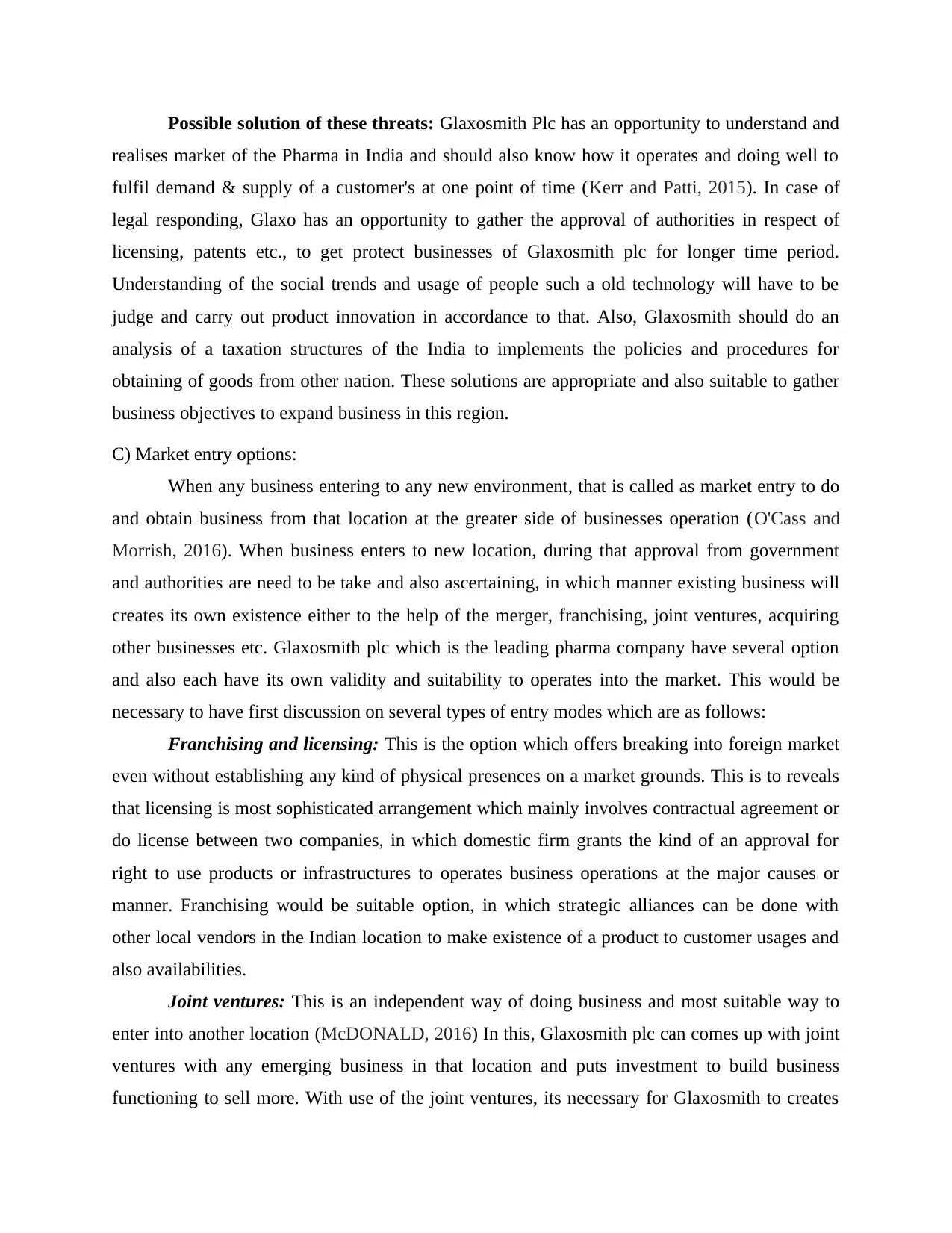
Possible solution of these threats: Glaxosmith Plc has an opportunity to understand and
realises market of the Pharma in India and should also know how it operates and doing well to
fulfil demand & supply of a customer's at one point of time (Kerr and Patti, 2015). In case of
legal responding, Glaxo has an opportunity to gather the approval of authorities in respect of
licensing, patents etc., to get protect businesses of Glaxosmith plc for longer time period.
Understanding of the social trends and usage of people such a old technology will have to be
judge and carry out product innovation in accordance to that. Also, Glaxosmith should do an
analysis of a taxation structures of the India to implements the policies and procedures for
obtaining of goods from other nation. These solutions are appropriate and also suitable to gather
business objectives to expand business in this region.
C) Market entry options:
When any business entering to any new environment, that is called as market entry to do
and obtain business from that location at the greater side of businesses operation (O'Cass and
Morrish, 2016). When business enters to new location, during that approval from government
and authorities are need to be take and also ascertaining, in which manner existing business will
creates its own existence either to the help of the merger, franchising, joint ventures, acquiring
other businesses etc. Glaxosmith plc which is the leading pharma company have several option
and also each have its own validity and suitability to operates into the market. This would be
necessary to have first discussion on several types of entry modes which are as follows:
Franchising and licensing: This is the option which offers breaking into foreign market
even without establishing any kind of physical presences on a market grounds. This is to reveals
that licensing is most sophisticated arrangement which mainly involves contractual agreement or
do license between two companies, in which domestic firm grants the kind of an approval for
right to use products or infrastructures to operates business operations at the major causes or
manner. Franchising would be suitable option, in which strategic alliances can be done with
other local vendors in the Indian location to make existence of a product to customer usages and
also availabilities.
Joint ventures: This is an independent way of doing business and most suitable way to
enter into another location (McDONALD, 2016) In this, Glaxosmith plc can comes up with joint
ventures with any emerging business in that location and puts investment to build business
functioning to sell more. With use of the joint ventures, its necessary for Glaxosmith to creates
realises market of the Pharma in India and should also know how it operates and doing well to
fulfil demand & supply of a customer's at one point of time (Kerr and Patti, 2015). In case of
legal responding, Glaxo has an opportunity to gather the approval of authorities in respect of
licensing, patents etc., to get protect businesses of Glaxosmith plc for longer time period.
Understanding of the social trends and usage of people such a old technology will have to be
judge and carry out product innovation in accordance to that. Also, Glaxosmith should do an
analysis of a taxation structures of the India to implements the policies and procedures for
obtaining of goods from other nation. These solutions are appropriate and also suitable to gather
business objectives to expand business in this region.
C) Market entry options:
When any business entering to any new environment, that is called as market entry to do
and obtain business from that location at the greater side of businesses operation (O'Cass and
Morrish, 2016). When business enters to new location, during that approval from government
and authorities are need to be take and also ascertaining, in which manner existing business will
creates its own existence either to the help of the merger, franchising, joint ventures, acquiring
other businesses etc. Glaxosmith plc which is the leading pharma company have several option
and also each have its own validity and suitability to operates into the market. This would be
necessary to have first discussion on several types of entry modes which are as follows:
Franchising and licensing: This is the option which offers breaking into foreign market
even without establishing any kind of physical presences on a market grounds. This is to reveals
that licensing is most sophisticated arrangement which mainly involves contractual agreement or
do license between two companies, in which domestic firm grants the kind of an approval for
right to use products or infrastructures to operates business operations at the major causes or
manner. Franchising would be suitable option, in which strategic alliances can be done with
other local vendors in the Indian location to make existence of a product to customer usages and
also availabilities.
Joint ventures: This is an independent way of doing business and most suitable way to
enter into another location (McDONALD, 2016) In this, Glaxosmith plc can comes up with joint
ventures with any emerging business in that location and puts investment to build business
functioning to sell more. With use of the joint ventures, its necessary for Glaxosmith to creates
⊘ This is a preview!⊘
Do you want full access?
Subscribe today to unlock all pages.

Trusted by 1+ million students worldwide
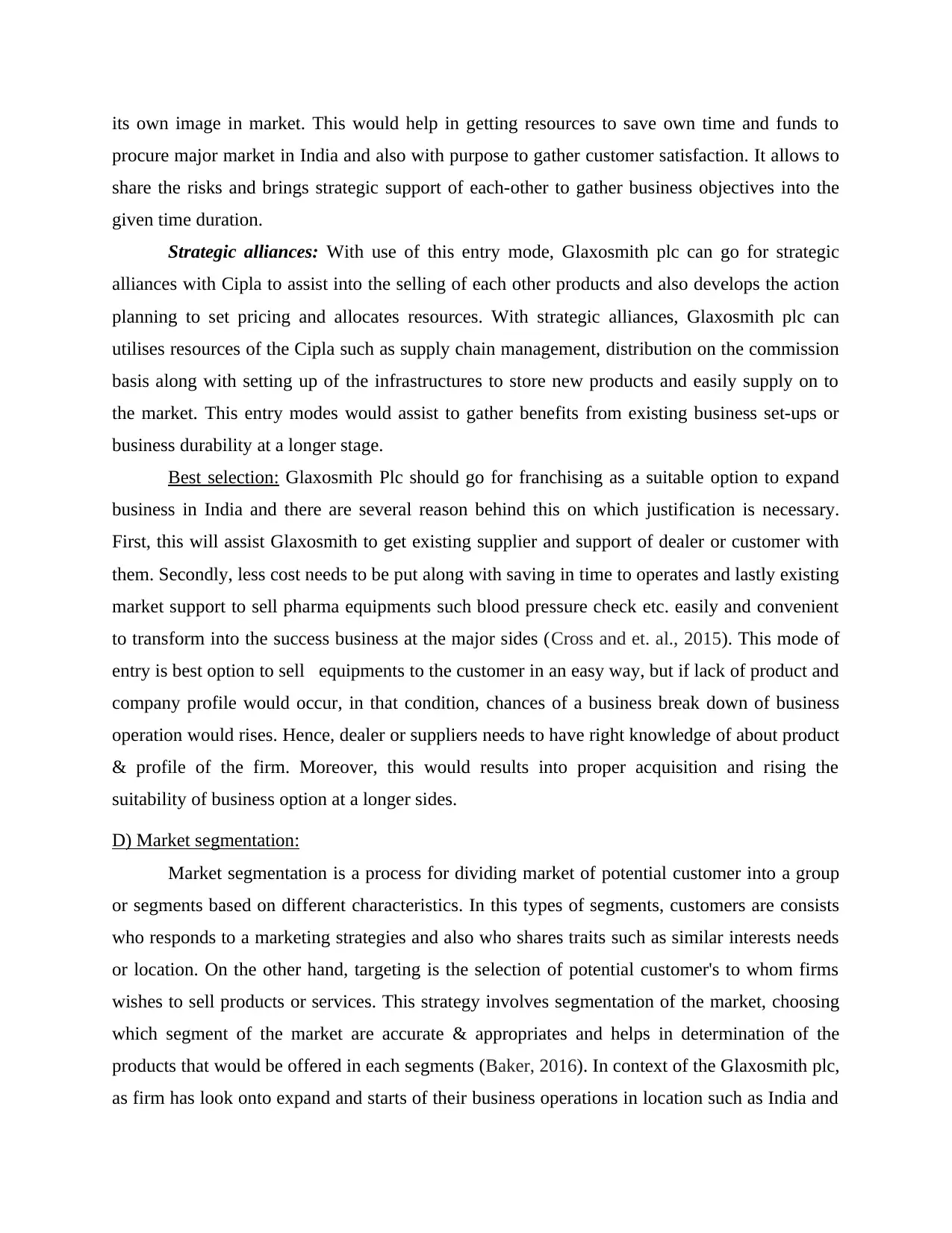
its own image in market. This would help in getting resources to save own time and funds to
procure major market in India and also with purpose to gather customer satisfaction. It allows to
share the risks and brings strategic support of each-other to gather business objectives into the
given time duration.
Strategic alliances: With use of this entry mode, Glaxosmith plc can go for strategic
alliances with Cipla to assist into the selling of each other products and also develops the action
planning to set pricing and allocates resources. With strategic alliances, Glaxosmith plc can
utilises resources of the Cipla such as supply chain management, distribution on the commission
basis along with setting up of the infrastructures to store new products and easily supply on to
the market. This entry modes would assist to gather benefits from existing business set-ups or
business durability at a longer stage.
Best selection: Glaxosmith Plc should go for franchising as a suitable option to expand
business in India and there are several reason behind this on which justification is necessary.
First, this will assist Glaxosmith to get existing supplier and support of dealer or customer with
them. Secondly, less cost needs to be put along with saving in time to operates and lastly existing
market support to sell pharma equipments such blood pressure check etc. easily and convenient
to transform into the success business at the major sides (Cross and et. al., 2015). This mode of
entry is best option to sell equipments to the customer in an easy way, but if lack of product and
company profile would occur, in that condition, chances of a business break down of business
operation would rises. Hence, dealer or suppliers needs to have right knowledge of about product
& profile of the firm. Moreover, this would results into proper acquisition and rising the
suitability of business option at a longer sides.
D) Market segmentation:
Market segmentation is a process for dividing market of potential customer into a group
or segments based on different characteristics. In this types of segments, customers are consists
who responds to a marketing strategies and also who shares traits such as similar interests needs
or location. On the other hand, targeting is the selection of potential customer's to whom firms
wishes to sell products or services. This strategy involves segmentation of the market, choosing
which segment of the market are accurate & appropriates and helps in determination of the
products that would be offered in each segments (Baker, 2016). In context of the Glaxosmith plc,
as firm has look onto expand and starts of their business operations in location such as India and
procure major market in India and also with purpose to gather customer satisfaction. It allows to
share the risks and brings strategic support of each-other to gather business objectives into the
given time duration.
Strategic alliances: With use of this entry mode, Glaxosmith plc can go for strategic
alliances with Cipla to assist into the selling of each other products and also develops the action
planning to set pricing and allocates resources. With strategic alliances, Glaxosmith plc can
utilises resources of the Cipla such as supply chain management, distribution on the commission
basis along with setting up of the infrastructures to store new products and easily supply on to
the market. This entry modes would assist to gather benefits from existing business set-ups or
business durability at a longer stage.
Best selection: Glaxosmith Plc should go for franchising as a suitable option to expand
business in India and there are several reason behind this on which justification is necessary.
First, this will assist Glaxosmith to get existing supplier and support of dealer or customer with
them. Secondly, less cost needs to be put along with saving in time to operates and lastly existing
market support to sell pharma equipments such blood pressure check etc. easily and convenient
to transform into the success business at the major sides (Cross and et. al., 2015). This mode of
entry is best option to sell equipments to the customer in an easy way, but if lack of product and
company profile would occur, in that condition, chances of a business break down of business
operation would rises. Hence, dealer or suppliers needs to have right knowledge of about product
& profile of the firm. Moreover, this would results into proper acquisition and rising the
suitability of business option at a longer sides.
D) Market segmentation:
Market segmentation is a process for dividing market of potential customer into a group
or segments based on different characteristics. In this types of segments, customers are consists
who responds to a marketing strategies and also who shares traits such as similar interests needs
or location. On the other hand, targeting is the selection of potential customer's to whom firms
wishes to sell products or services. This strategy involves segmentation of the market, choosing
which segment of the market are accurate & appropriates and helps in determination of the
products that would be offered in each segments (Baker, 2016). In context of the Glaxosmith plc,
as firm has look onto expand and starts of their business operations in location such as India and
Paraphrase This Document
Need a fresh take? Get an instant paraphrase of this document with our AI Paraphraser
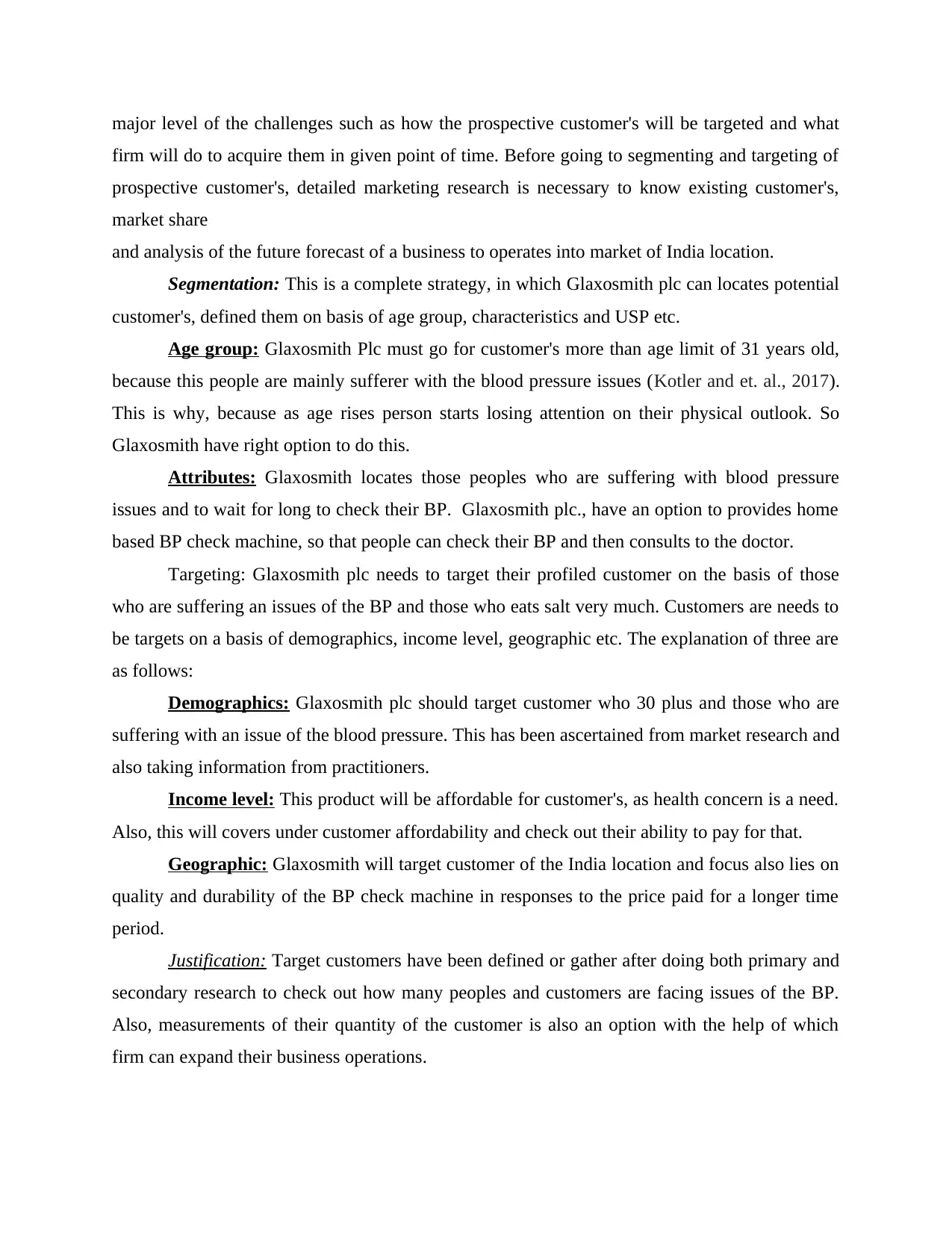
major level of the challenges such as how the prospective customer's will be targeted and what
firm will do to acquire them in given point of time. Before going to segmenting and targeting of
prospective customer's, detailed marketing research is necessary to know existing customer's,
market share
and analysis of the future forecast of a business to operates into market of India location.
Segmentation: This is a complete strategy, in which Glaxosmith plc can locates potential
customer's, defined them on basis of age group, characteristics and USP etc.
Age group: Glaxosmith Plc must go for customer's more than age limit of 31 years old,
because this people are mainly sufferer with the blood pressure issues (Kotler and et. al., 2017).
This is why, because as age rises person starts losing attention on their physical outlook. So
Glaxosmith have right option to do this.
Attributes: Glaxosmith locates those peoples who are suffering with blood pressure
issues and to wait for long to check their BP. Glaxosmith plc., have an option to provides home
based BP check machine, so that people can check their BP and then consults to the doctor.
Targeting: Glaxosmith plc needs to target their profiled customer on the basis of those
who are suffering an issues of the BP and those who eats salt very much. Customers are needs to
be targets on a basis of demographics, income level, geographic etc. The explanation of three are
as follows:
Demographics: Glaxosmith plc should target customer who 30 plus and those who are
suffering with an issue of the blood pressure. This has been ascertained from market research and
also taking information from practitioners.
Income level: This product will be affordable for customer's, as health concern is a need.
Also, this will covers under customer affordability and check out their ability to pay for that.
Geographic: Glaxosmith will target customer of the India location and focus also lies on
quality and durability of the BP check machine in responses to the price paid for a longer time
period.
Justification: Target customers have been defined or gather after doing both primary and
secondary research to check out how many peoples and customers are facing issues of the BP.
Also, measurements of their quantity of the customer is also an option with the help of which
firm can expand their business operations.
firm will do to acquire them in given point of time. Before going to segmenting and targeting of
prospective customer's, detailed marketing research is necessary to know existing customer's,
market share
and analysis of the future forecast of a business to operates into market of India location.
Segmentation: This is a complete strategy, in which Glaxosmith plc can locates potential
customer's, defined them on basis of age group, characteristics and USP etc.
Age group: Glaxosmith Plc must go for customer's more than age limit of 31 years old,
because this people are mainly sufferer with the blood pressure issues (Kotler and et. al., 2017).
This is why, because as age rises person starts losing attention on their physical outlook. So
Glaxosmith have right option to do this.
Attributes: Glaxosmith locates those peoples who are suffering with blood pressure
issues and to wait for long to check their BP. Glaxosmith plc., have an option to provides home
based BP check machine, so that people can check their BP and then consults to the doctor.
Targeting: Glaxosmith plc needs to target their profiled customer on the basis of those
who are suffering an issues of the BP and those who eats salt very much. Customers are needs to
be targets on a basis of demographics, income level, geographic etc. The explanation of three are
as follows:
Demographics: Glaxosmith plc should target customer who 30 plus and those who are
suffering with an issue of the blood pressure. This has been ascertained from market research and
also taking information from practitioners.
Income level: This product will be affordable for customer's, as health concern is a need.
Also, this will covers under customer affordability and check out their ability to pay for that.
Geographic: Glaxosmith will target customer of the India location and focus also lies on
quality and durability of the BP check machine in responses to the price paid for a longer time
period.
Justification: Target customers have been defined or gather after doing both primary and
secondary research to check out how many peoples and customers are facing issues of the BP.
Also, measurements of their quantity of the customer is also an option with the help of which
firm can expand their business operations.

E) Porter generic:
Porter generic strategy is the marketing strategic model that is used to check firm's
relative position within its industry to determines whether firm is going profitable or running
below an industry averages (Josephson and et. al., 2016). This model is comprised of four
components: cost leadership, focus and differential strategy which would be used to check
strategic position of the firm as well as aim to carry out with focus on pricing and USP of the
products to increases the business growth and sustainability for longer time duration. The major
discussion over three different strategies are as follows:
Cost leadership: In this strategy, business entity have an to sets out action plan to become
low cost producer into the pharma industry. As per business context, chances and scope for cos t
advantage is wide and business entities have scope to lead the market. They may include the
pursuit of economies of scale, proprietary technology, preferential access to raw materials and
other factors (Hollebeek and et. al., 2016). The low cost producer may have option to finds and
also exploit all sources of cost advantages. This would assist firm to lower down prices of the
BP equipments.
Differentiation: In this strategy, a business firm seeks to have unique in its own industry
along with some dimension that are widely valued by buyers. This puts consideration on one or
more attributes that buyers in an industry perceives as important. In this, differentiation such as
product viability, measuring USP and characteristics of the product in market structures. It helps
in providing uniqueness of products at premium pricing.
Focus: In this stage of generic strategy, selection is used to be done for choice of a
narrow competitive scope within the pharma industry (Štefko and et. al., 2015). In this strategy,
focuser will have to selects out the segment or group of segments in pharma industry and tailor
out the proper action plan to gather or increases business validity for a longer period of time.
Thus, focus would have right choices to gather and accomplishes business objectives to give
growth. Focus strategy are of two types namely: cost and differentiation.
Porter generic strategy is the marketing strategic model that is used to check firm's
relative position within its industry to determines whether firm is going profitable or running
below an industry averages (Josephson and et. al., 2016). This model is comprised of four
components: cost leadership, focus and differential strategy which would be used to check
strategic position of the firm as well as aim to carry out with focus on pricing and USP of the
products to increases the business growth and sustainability for longer time duration. The major
discussion over three different strategies are as follows:
Cost leadership: In this strategy, business entity have an to sets out action plan to become
low cost producer into the pharma industry. As per business context, chances and scope for cos t
advantage is wide and business entities have scope to lead the market. They may include the
pursuit of economies of scale, proprietary technology, preferential access to raw materials and
other factors (Hollebeek and et. al., 2016). The low cost producer may have option to finds and
also exploit all sources of cost advantages. This would assist firm to lower down prices of the
BP equipments.
Differentiation: In this strategy, a business firm seeks to have unique in its own industry
along with some dimension that are widely valued by buyers. This puts consideration on one or
more attributes that buyers in an industry perceives as important. In this, differentiation such as
product viability, measuring USP and characteristics of the product in market structures. It helps
in providing uniqueness of products at premium pricing.
Focus: In this stage of generic strategy, selection is used to be done for choice of a
narrow competitive scope within the pharma industry (Štefko and et. al., 2015). In this strategy,
focuser will have to selects out the segment or group of segments in pharma industry and tailor
out the proper action plan to gather or increases business validity for a longer period of time.
Thus, focus would have right choices to gather and accomplishes business objectives to give
growth. Focus strategy are of two types namely: cost and differentiation.
⊘ This is a preview!⊘
Do you want full access?
Subscribe today to unlock all pages.

Trusted by 1+ million students worldwide
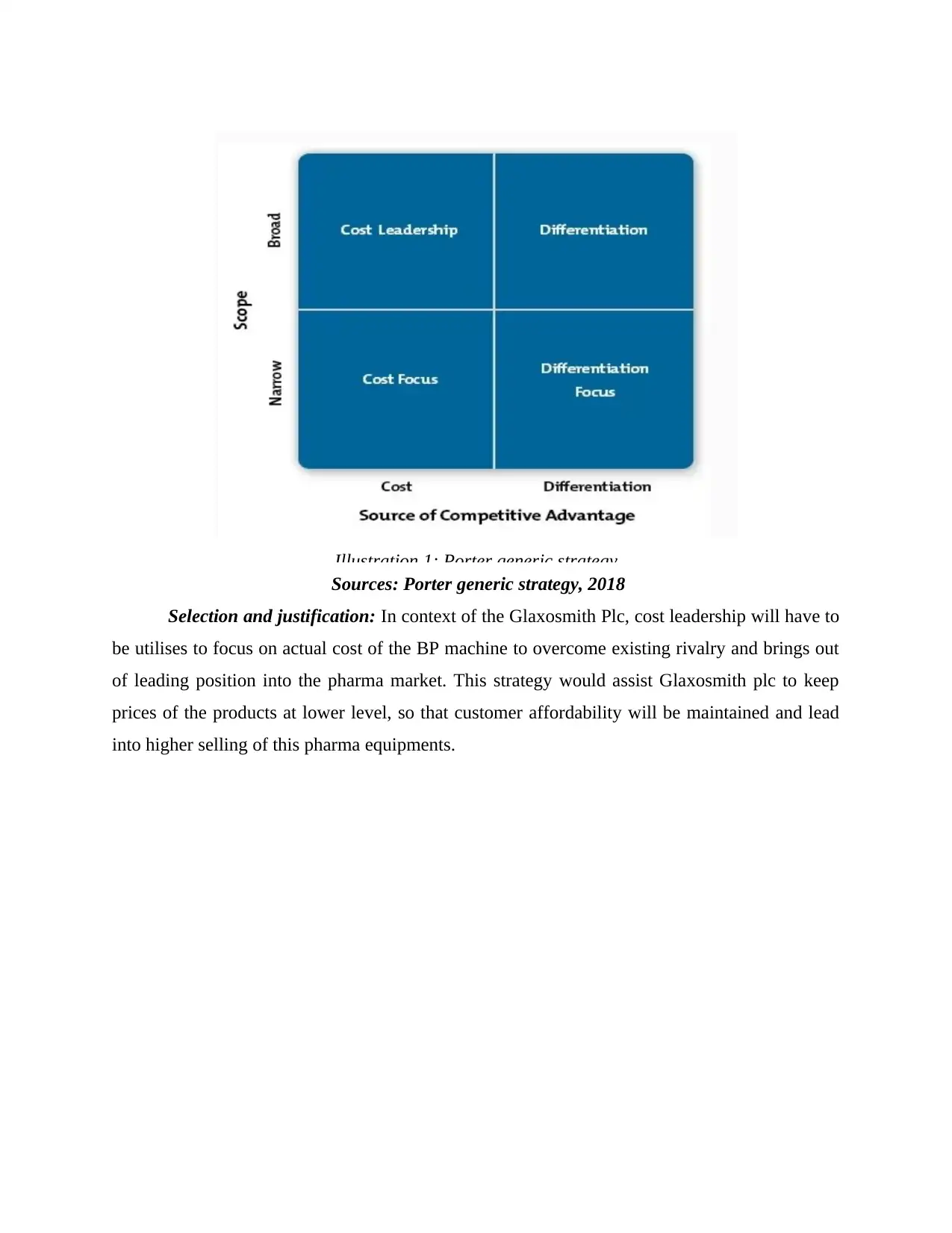
Sources: Porter generic strategy, 2018
Selection and justification: In context of the Glaxosmith Plc, cost leadership will have to
be utilises to focus on actual cost of the BP machine to overcome existing rivalry and brings out
of leading position into the pharma market. This strategy would assist Glaxosmith plc to keep
prices of the products at lower level, so that customer affordability will be maintained and lead
into higher selling of this pharma equipments.
Illustration 1: Porter generic strategy
Selection and justification: In context of the Glaxosmith Plc, cost leadership will have to
be utilises to focus on actual cost of the BP machine to overcome existing rivalry and brings out
of leading position into the pharma market. This strategy would assist Glaxosmith plc to keep
prices of the products at lower level, so that customer affordability will be maintained and lead
into higher selling of this pharma equipments.
Illustration 1: Porter generic strategy
Paraphrase This Document
Need a fresh take? Get an instant paraphrase of this document with our AI Paraphraser
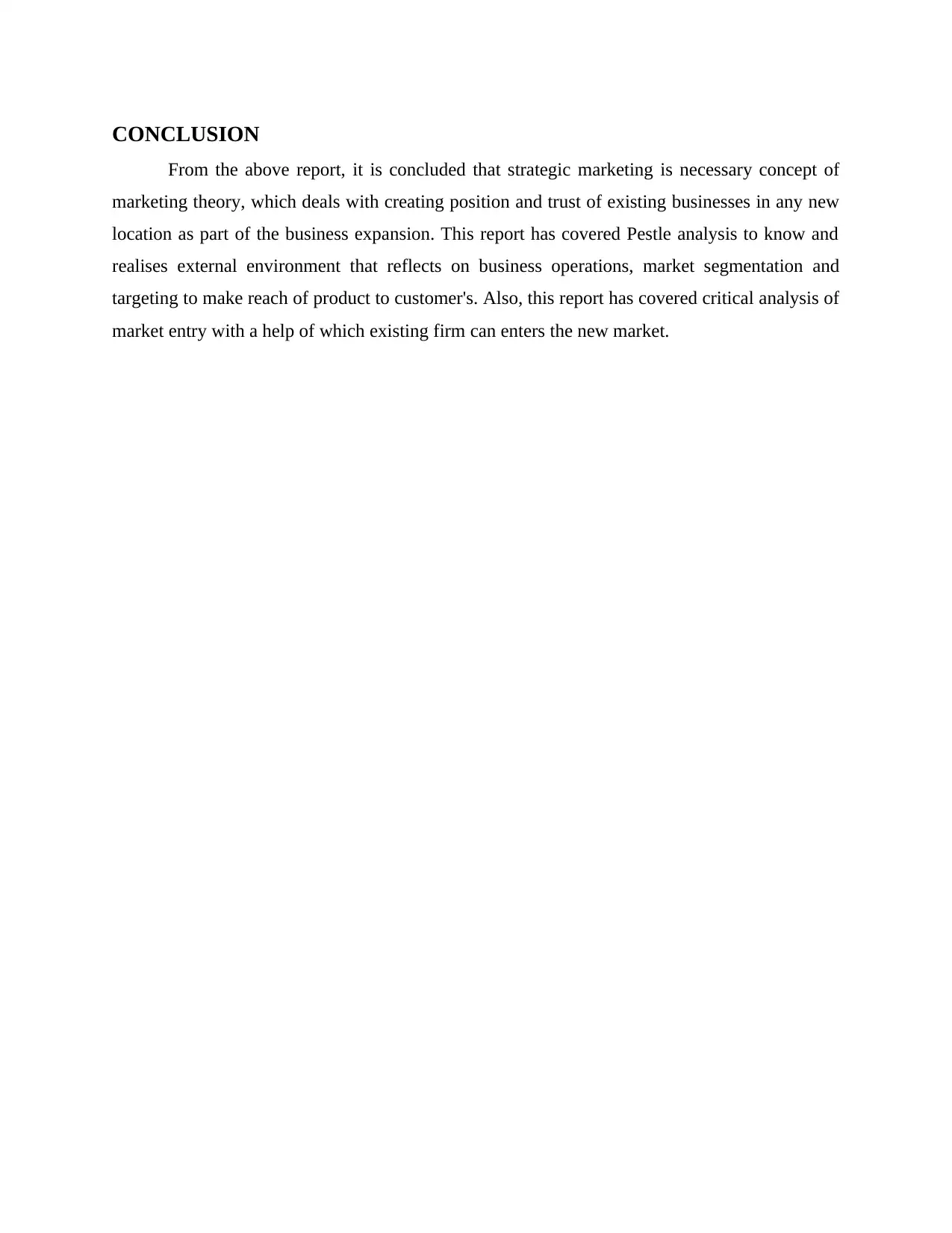
CONCLUSION
From the above report, it is concluded that strategic marketing is necessary concept of
marketing theory, which deals with creating position and trust of existing businesses in any new
location as part of the business expansion. This report has covered Pestle analysis to know and
realises external environment that reflects on business operations, market segmentation and
targeting to make reach of product to customer's. Also, this report has covered critical analysis of
market entry with a help of which existing firm can enters the new market.
From the above report, it is concluded that strategic marketing is necessary concept of
marketing theory, which deals with creating position and trust of existing businesses in any new
location as part of the business expansion. This report has covered Pestle analysis to know and
realises external environment that reflects on business operations, market segmentation and
targeting to make reach of product to customer's. Also, this report has covered critical analysis of
market entry with a help of which existing firm can enters the new market.
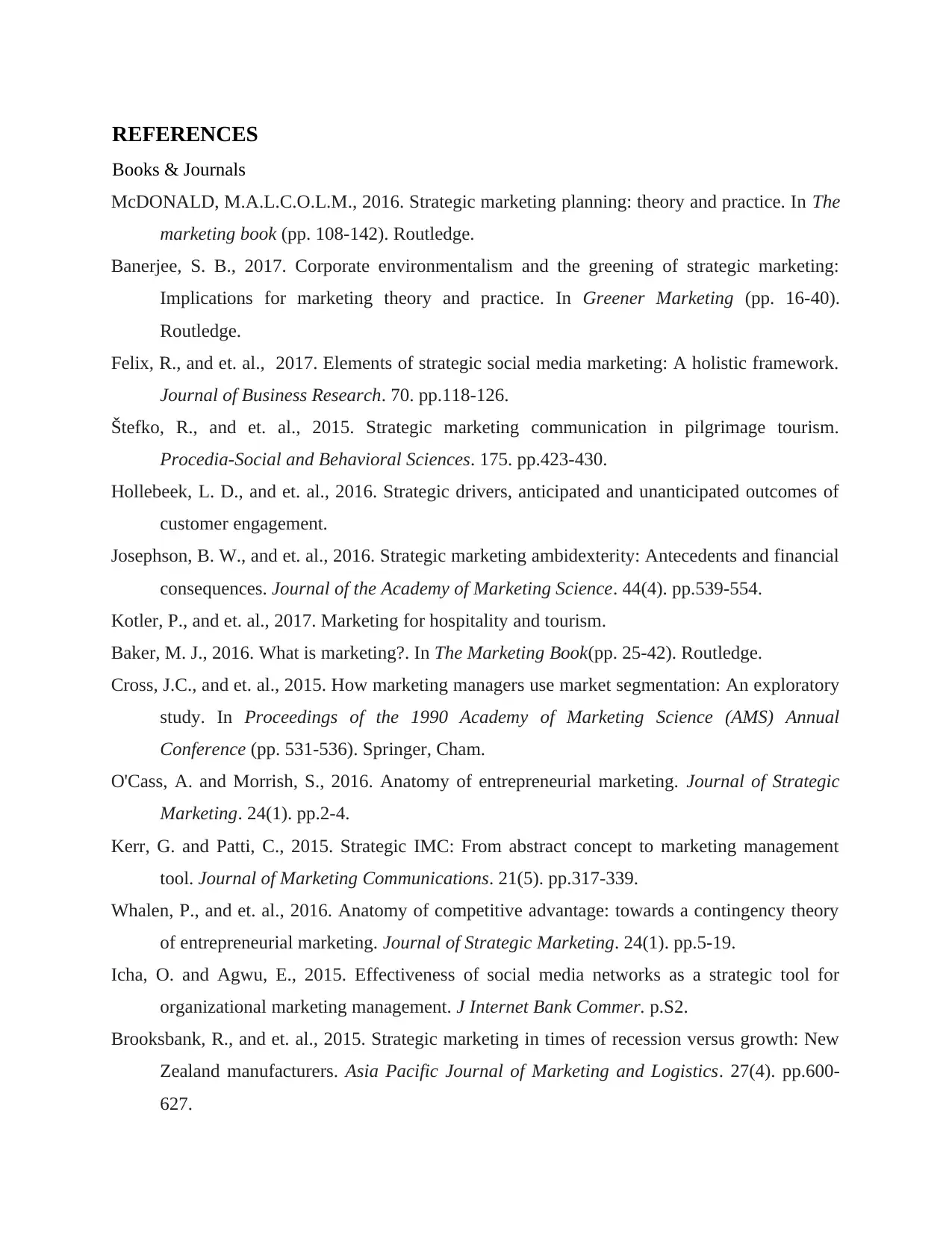
REFERENCES
Books & Journals
McDONALD, M.A.L.C.O.L.M., 2016. Strategic marketing planning: theory and practice. In The
marketing book (pp. 108-142). Routledge.
Banerjee, S. B., 2017. Corporate environmentalism and the greening of strategic marketing:
Implications for marketing theory and practice. In Greener Marketing (pp. 16-40).
Routledge.
Felix, R., and et. al., 2017. Elements of strategic social media marketing: A holistic framework.
Journal of Business Research. 70. pp.118-126.
Štefko, R., and et. al., 2015. Strategic marketing communication in pilgrimage tourism.
Procedia-Social and Behavioral Sciences. 175. pp.423-430.
Hollebeek, L. D., and et. al., 2016. Strategic drivers, anticipated and unanticipated outcomes of
customer engagement.
Josephson, B. W., and et. al., 2016. Strategic marketing ambidexterity: Antecedents and financial
consequences. Journal of the Academy of Marketing Science. 44(4). pp.539-554.
Kotler, P., and et. al., 2017. Marketing for hospitality and tourism.
Baker, M. J., 2016. What is marketing?. In The Marketing Book(pp. 25-42). Routledge.
Cross, J.C., and et. al., 2015. How marketing managers use market segmentation: An exploratory
study. In Proceedings of the 1990 Academy of Marketing Science (AMS) Annual
Conference (pp. 531-536). Springer, Cham.
O'Cass, A. and Morrish, S., 2016. Anatomy of entrepreneurial marketing. Journal of Strategic
Marketing. 24(1). pp.2-4.
Kerr, G. and Patti, C., 2015. Strategic IMC: From abstract concept to marketing management
tool. Journal of Marketing Communications. 21(5). pp.317-339.
Whalen, P., and et. al., 2016. Anatomy of competitive advantage: towards a contingency theory
of entrepreneurial marketing. Journal of Strategic Marketing. 24(1). pp.5-19.
Icha, O. and Agwu, E., 2015. Effectiveness of social media networks as a strategic tool for
organizational marketing management. J Internet Bank Commer. p.S2.
Brooksbank, R., and et. al., 2015. Strategic marketing in times of recession versus growth: New
Zealand manufacturers. Asia Pacific Journal of Marketing and Logistics. 27(4). pp.600-
627.
Books & Journals
McDONALD, M.A.L.C.O.L.M., 2016. Strategic marketing planning: theory and practice. In The
marketing book (pp. 108-142). Routledge.
Banerjee, S. B., 2017. Corporate environmentalism and the greening of strategic marketing:
Implications for marketing theory and practice. In Greener Marketing (pp. 16-40).
Routledge.
Felix, R., and et. al., 2017. Elements of strategic social media marketing: A holistic framework.
Journal of Business Research. 70. pp.118-126.
Štefko, R., and et. al., 2015. Strategic marketing communication in pilgrimage tourism.
Procedia-Social and Behavioral Sciences. 175. pp.423-430.
Hollebeek, L. D., and et. al., 2016. Strategic drivers, anticipated and unanticipated outcomes of
customer engagement.
Josephson, B. W., and et. al., 2016. Strategic marketing ambidexterity: Antecedents and financial
consequences. Journal of the Academy of Marketing Science. 44(4). pp.539-554.
Kotler, P., and et. al., 2017. Marketing for hospitality and tourism.
Baker, M. J., 2016. What is marketing?. In The Marketing Book(pp. 25-42). Routledge.
Cross, J.C., and et. al., 2015. How marketing managers use market segmentation: An exploratory
study. In Proceedings of the 1990 Academy of Marketing Science (AMS) Annual
Conference (pp. 531-536). Springer, Cham.
O'Cass, A. and Morrish, S., 2016. Anatomy of entrepreneurial marketing. Journal of Strategic
Marketing. 24(1). pp.2-4.
Kerr, G. and Patti, C., 2015. Strategic IMC: From abstract concept to marketing management
tool. Journal of Marketing Communications. 21(5). pp.317-339.
Whalen, P., and et. al., 2016. Anatomy of competitive advantage: towards a contingency theory
of entrepreneurial marketing. Journal of Strategic Marketing. 24(1). pp.5-19.
Icha, O. and Agwu, E., 2015. Effectiveness of social media networks as a strategic tool for
organizational marketing management. J Internet Bank Commer. p.S2.
Brooksbank, R., and et. al., 2015. Strategic marketing in times of recession versus growth: New
Zealand manufacturers. Asia Pacific Journal of Marketing and Logistics. 27(4). pp.600-
627.
⊘ This is a preview!⊘
Do you want full access?
Subscribe today to unlock all pages.

Trusted by 1+ million students worldwide
1 out of 13
Related Documents
Your All-in-One AI-Powered Toolkit for Academic Success.
+13062052269
info@desklib.com
Available 24*7 on WhatsApp / Email
![[object Object]](/_next/static/media/star-bottom.7253800d.svg)
Unlock your academic potential
Copyright © 2020–2025 A2Z Services. All Rights Reserved. Developed and managed by ZUCOL.





